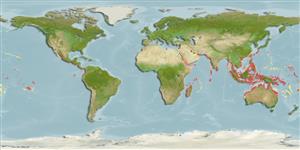Environment: milieu / climate zone / depth range / distribution range
Écologie
marin; eau douce; saumâtre démersal; catadrome (Ref. 46888); profondeur 0 - 5 m (Ref. 86942). Tropical; 30°N - 35°S, 24°E - 138°W
Indo-Pacific: Persian Gulf (Ref.80050) and Red Sea to Samoa, north to Japan. Collected at Natal, South Africa (Ref. 11228).
Taille / Poids / Âge
Maturity: Lm ? range ? - ? cm
Max length : 40.0 cm SL mâle / non sexé; (Ref. 9812); common length : 25.0 cm TL mâle / non sexé; (Ref. 9812)
Épines dorsales (Total) : 4 - 5; Rayons mous dorsaux (Total) : 8 - 9; Épines anales: 3; Rayons mous anaux: 9. Dark greenish dorsally, brownish over head, white ventrally; 3-6 indistinct, dark stripes along upper rows of scales; greyish dorsal fins; caudal fin bluish with black margin (Ref. 9812). Yellowish pectoral fin and may have a blue spot at fin origin (Ref. 9812).
Form schools in shallow coastal waters and enters lagoons, estuaries, and fresh water to feed (Ref. 9812). Juveniles may enter rice fields and mangroves (Ref. 9812). Feed on small algae, diatoms and benthic detrital material taken in with sand and mud; fry take zooplankton, diatoms, detrital material and inorganic sediment (Ref. 9812). Oviparous, eggs are pelagic and non-adhesive (Ref. 205). Spawning occurs at sea. Also caught with stakenets (Ref. 9812). Marketed fresh and salted.
Life cycle and mating behavior
Maturité | Reproduction | Frai | Œufs | Fécondité | Larves
Thomson, J.M., 1984. Mugilidae. In W. Fischer and G. Bianchi (eds.) FAO species identification sheets for fishery purposes. Western Indian Ocean (Fishing Area 51). volume 3. [pag. var.]. FAO, Rome. (Ref. 2830)
Statut dans la liste rouge de l'IUCN (Ref. 130435: Version 2024-1)
Menace pour l'homme
Harmless
Utilisations par l'homme
Pêcheries: commercial; Aquaculture: commercial; appât: usually
Outils
Articles particuliers
Télécharger en XML
Sources Internet
Estimates based on models
Preferred temperature (Ref.
123201): 25.2 - 29.3, mean 28.4 °C (based on 3436 cells).
Phylogenetic diversity index (Ref.
82804): PD
50 = 0.5078 [Uniqueness, from 0.5 = low to 2.0 = high].
Bayesian length-weight: a=0.01259 (0.01055 - 0.01502), b=2.93 (2.90 - 2.96), in cm total length, based on LWR estimates for this species (Ref.
93245).
Niveau trophique (Ref.
69278): 2.7 ±0.30 se; based on food items.
Résilience (Ref.
120179): Milieu, temps minimum de doublement de population : 1,4 à 4,4 années (K=0.15-0.63).
Fishing Vulnerability (Ref.
59153): Low to moderate vulnerability (32 of 100).
Nutrients (Ref.
124155): Calcium = 173 [76, 396] mg/100g; Iron = 1.16 [0.53, 2.47] mg/100g; Protein = 18.2 [16.5, 19.9] %; Omega3 = 0.262 [0.128, 0.590] g/100g; Selenium = 31.5 [15.5, 77.1] μg/100g; VitaminA = 24 [6, 81] μg/100g; Zinc = 1.86 [1.24, 2.81] mg/100g (wet weight);
